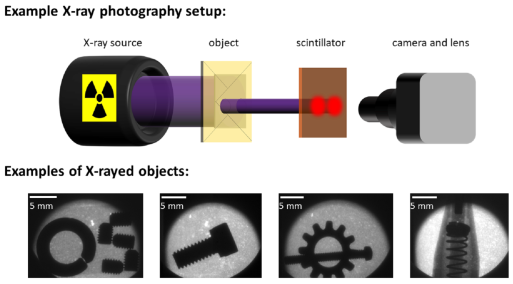In a study published in Nature Communications, scientists at the US Department of Energy’s (DOE) Argonne National Laboratory may have discovered a solution to deciding whether fast imaging or optimal performance was more important when selecting the appropriate scintillator technology for a specific experiment.
 A graphical representation of the type of X-ray imaging setup that could employ the new colloidal quantum shell-based scintillation technology. Image Credit: Burak Guzelturk & Benjamin T. Diroll/Argonne National Laboratory
A graphical representation of the type of X-ray imaging setup that could employ the new colloidal quantum shell-based scintillation technology. Image Credit: Burak Guzelturk & Benjamin T. Diroll/Argonne National Laboratory
Scintillators are detectors that create an image by causing high-energy X-rays or particles to become visible through light bursts. Particle physics, medical imaging, X-ray security, and other fields are among their numerous uses.
However, scintillators have given researchers a dilemma despite their value.
The scintillator material used in the new solution consists of spherical particles 20 billionths of a meter in size. These nanoparticles, despite their extremely small size, have a complex structure consisting of a ball-like core of cadmium sulfide encircled by a thicker shell of cadmium sulfide and a thin shell of cadmium selenide. Scientists from Northwestern University, Bowling Green State University (BGSU), and DOE’s Oak Ridge National Laboratory worked together on this project.
These nanoparticles, known as quantum shells, have useful optical and electronic properties that are not achievable with larger particles because of quantum mechanical effects. BGSU researchers created them to create the tightly packed lattice that made up the scintillator material.
It can be used for high-resolution imaging and ultrafast radiation detection using X-ray light sources like the Advanced Photon Source (APS) at Argonne, a DOE Office of Science user facility.
A common application for scintillator technology is in a dentist’s office, where X-ray beams are shone through a patient’s mouth and onto a film of a reactive material that imprints an image of the teeth for the dentist to inspect for potential defects.
Although this type of imaging is useful for dentists and doctors performing chest X-rays, it is far from the power and precision required for nanoscale imaging, such as that performed by the APS. This necessitates scintillator materials that are efficient, fast to respond, have high spatial resolution, are long-lasting, and can be scaled to large dimensions.
The newly created quantum shells by the research team satisfy those requirements.
Quantum shells may be suitable for imaging in the dentist’s office, but they are much more well-suited for scintillators at a light source like the APS or for X-ray imaging of engines while they are running with liquids inside.
Burak Guzelturk, Physicist, X-Ray Science Division, Argonne National Laboratory
Benjamin Diroll, a scientist in the Center for Nanoscale Materials, a DOE Office of Science user facility at Argonne, added, “When traditional scintillators are excited by X-ray beams, they will emit light, and it will have some characteristic lifespan. In some of them, it might be hundreds of nanoseconds, or it might be microseconds. The quantum shell scintillator achieves a single-digit nanosecond lifetime while preserving efficiency levels equal to traditional scintillators.”
Guzelturk compared quantum shells with quantum dots, another substance that identically emits light.
He noted, “In a quantum dot, the light emission typically comes from the center part of the nano-object, and the color of light emitted depends on its size. On the other hand, in the quantum shells, the light emission does not originate from the core, but it’s actually the adjacent shell in the nanoparticle.”
The thickness of the shell affects how light is emitted. Quantum shell-based scintillator materials can provide quick, well-defined imaging as well as long-term durability.
Traditional scintillators are often fairly thick. Consequently, they can illuminate in the front, rear, or center, which tends to distort the intended image. Quantum shell scintillators avoid this issue because they can be manufactured as a thin film on a substrate material.
Guzelturk stated, “Commercial scintillators that are made of lighter elements need to be millimeters thick. In our case, we realized that we could make quantum shell scintillators much thinner, just a couple of micrometers while achieving both strong X-ray absorption and high spatial resolution imaging.”
Thanks to the development of quantum shell scintillators for high-resolution and ultrafast imaging, scientists can now overcome the drawbacks of conventional scintillator technology. This groundbreaking study demonstrates the extraordinary potential of these quantum materials at the nanoscale. By utilizing their distinct optical and electronic characteristics, researchers can explore new areas, from particle physics to medical diagnostics.
The other study authors are James Cassidy, Dulanjan Harankahage, Muchuan Hua, Xiao-Min Lin, Vasudevan Iyer, Richard D. Schaller, Benjamin J. Lawrie, and Mikhail Zamkov.
DOE Office of Basic Energy Sciences funded the study.
Journal Reference:
Guzelturk, B. et. al. (2024) Bright and durable scintillation from colloidal quantum shells. Nature Communications. doi.org/10.1038/s41467-024-48351-9